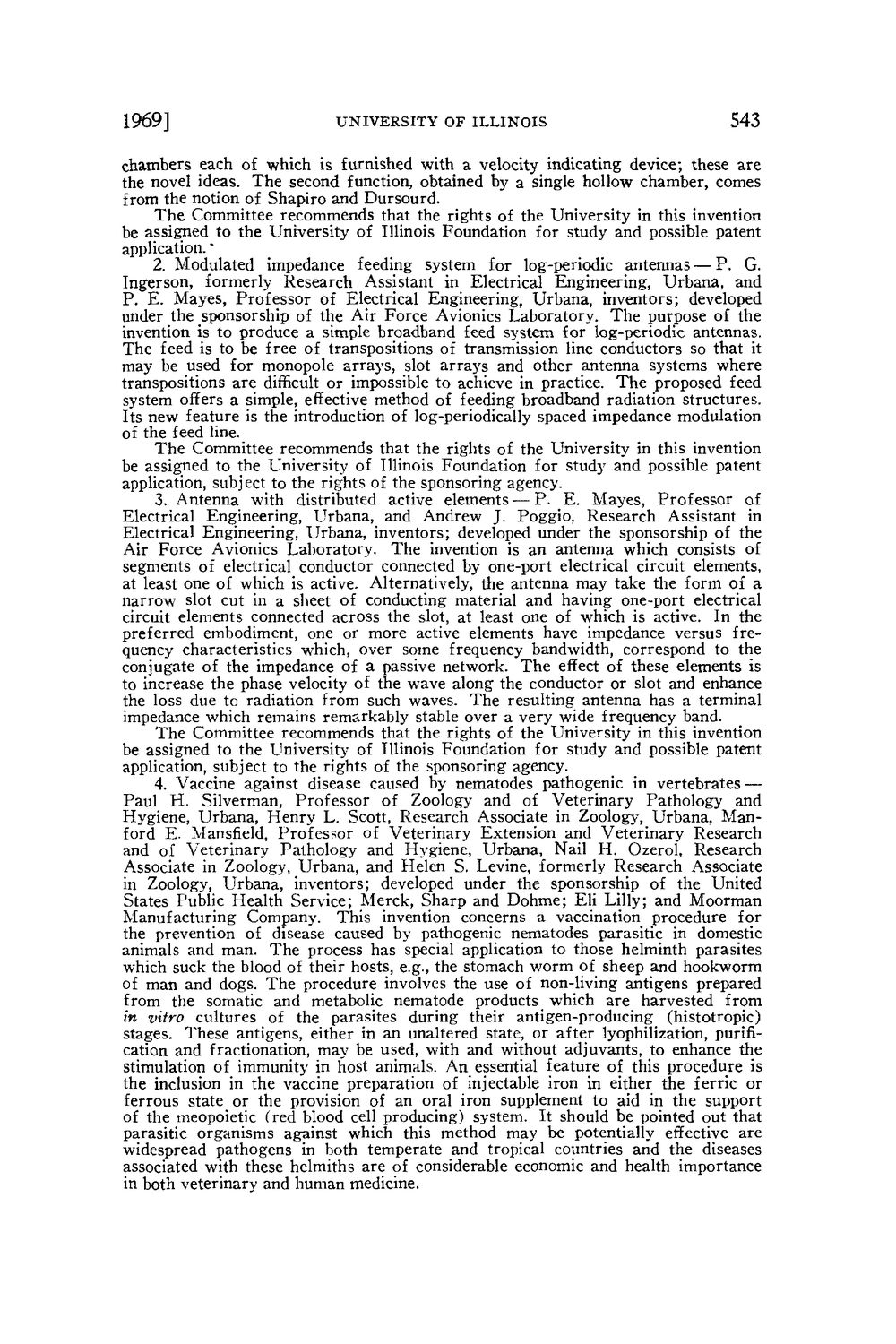| |
| |
Caption: Board of Trustees Minutes - 1970
This is a reduced-resolution page image for fast online browsing.

EXTRACTED TEXT FROM PAGE:
1969] UNIVERSITY OF I L L I N O I S 543 chambers each of which is furnished with a velocity indicating device; these are the novel ideas. The second function, obtained by a single hollow chamber, comes from the notion of Shapiro and Dursourd. T h e Committee recommends that the rights of the University in this invention be assigned to the University of Illinois Foundation for study and possible patent application.' 2. Modulated impedance feeding system for log-periodic antennas — P. G. Ingerson, formerly Research Assistant in Electrical Engineering, Urbana, and P. E. Mayes, Professor of Electrical Engineering, Urbana, inventors; developed under the sponsorship of the Air Force Avionics Laboratory. The purpose of the invention is to produce a simple broadband feed system for log-periodic antennas. The feed is to be free of transpositions of transmission line conductors so that it may be used for monopole arrays, slot arrays and other antenna systems where transpositions are difficult or impossible to achieve in practice. The proposed feed system offers a simple, effective method of feeding broadband radiation structures. Its new feature is the introduction of log-periodically spaced impedance modulation of the feed line. The Committee recommends that the rights of the University in this invention be assigned to the University of Illinois Foundation for study and possible patent application, subject to the rights of the sponsoring agency. 3. Antenna with distributed active elements — P . E. Mayes, Professor of Electrical Engineering, Urbana, and Andrew J. Poggio, Research Assistant in Electrical Engineering, Urbana, inventors; developed under the sponsorship of the Air Force Avionics Laboratory. The invention is an antenna which consists of segments of electrical conductor connected by one-port electrical circuit elements, at least one of which is active. Alternatively, the antenna may take the form of a narrow slot cut in a sheet of conducting material and having one-port electrical circuit elements connected across the slot, at least one of which is active. In the preferred embodiment, one or more active elements have impedance versus frequency characteristics which, over some frequency bandwidth, correspond to the conjugate of the impedance of a passive network. The effect of these elements is to increase the phase velocity of the wave along the conductor or slot and enhance the loss due to radiation from such waves. The resulting antenna has a terminal impedance which remains remarkably stable over a very wide frequency band. The Committee recommends that the rights of the University in this invention be assigned to the University of Illinois Foundation for study and possible patent application, subject to the rights of the sponsoring agency. 4. Vaccine against disease caused by nematodes pathogenic in vertebrates — Paul H. Silverman, Professor of Zoology and of Veterinary Pathology and Hygiene, Urbana, Henry L. Scott, Research Associate in Zoology, Urbana, Manford E. Mansfield, Professor of Veterinary Extension and Veterinary Research and of Veterinary Pathology and Hygiene, Urbana, Nail H. Ozerol, Research Associate in Zoology, Urbana, and Helen S. Levine, formerly Research Associate in Zoology, Urbana, inventors; developed under the sponsorship of the United States Public Health Service; Merck, Sharp and Dohme; Eli Lilly; and Moorman Manufacturing Company. This invention concerns a vaccination procedure for the prevention of disease caused by pathogenic nematodes parasitic in domestic animals and man. The process has special application to those helminth parasites which suck the blood of their hosts, e.g., the stomach worm of sheep and hookworm of man and dogs. The procedure involves the use of non-living antigens prepared from the somatic and metabolic nematode products which are harvested from in vitro cultures of the parasites during their antigen-producing (histotropic) stages. These antigens, either in an unaltered state, or after lyophilization, purification and fractionation, may be used, with and without adjuvants, to enhance the stimulation of immunity in host animals. An essential feature of this procedure is the inclusion in the vaccine preparation of injectable iron in either the ferric or ferrous state or the provision of an oral iron supplement to aid in the support of the meopoietic (red blood cell producing) system. It should be pointed out that parasitic organisms against which this method may be potentially effective are widespread pathogens in both temperate and tropical countries and the diseases associated with these helmiths are of considerable economic and health importance in both veterinary and human medicine.
| |